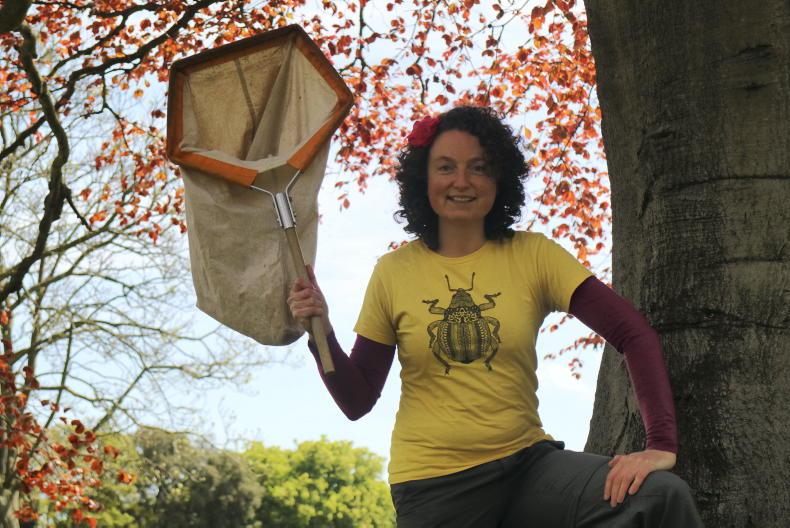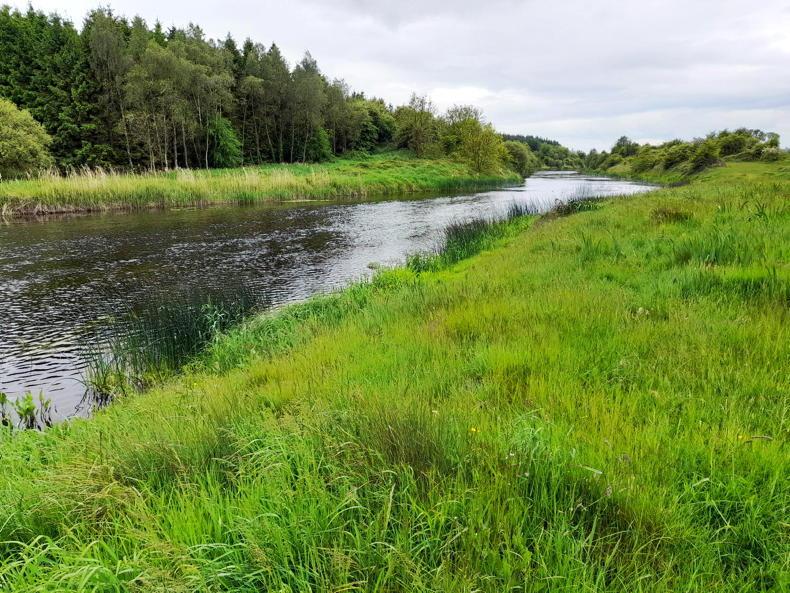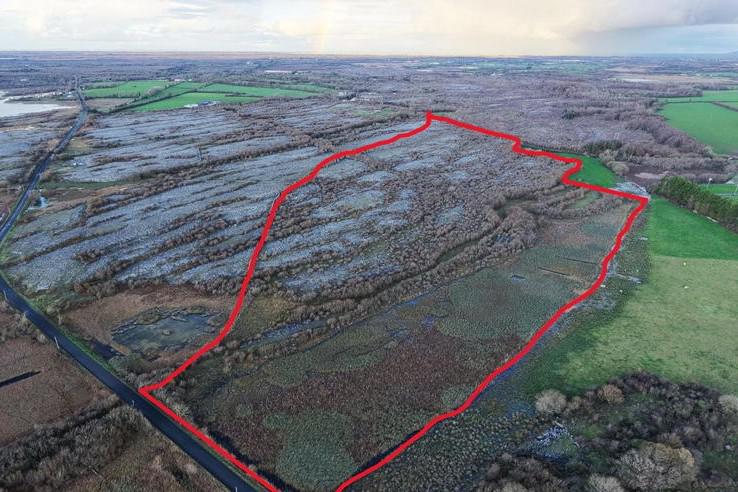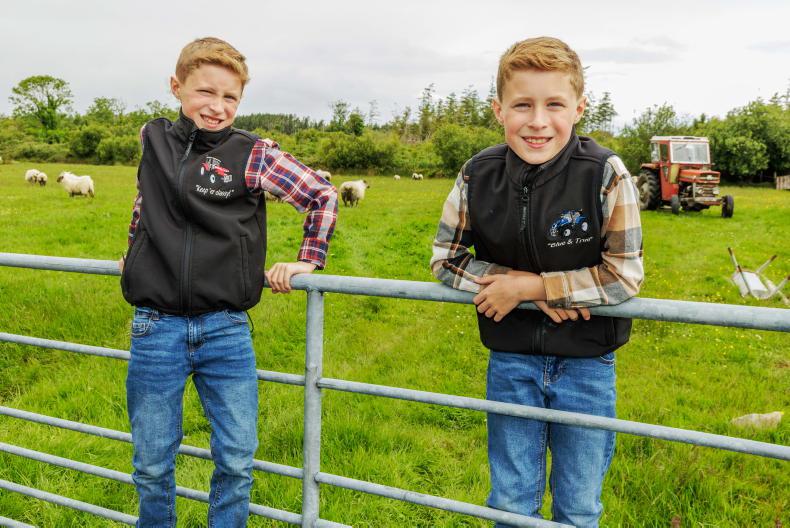Do you like bugs? I didn’t always like them. They’re creepy and crawly. Some of them bite or sting. Why would you want things like that living in your home, on the farm or in your garden? Once I learned more about them, however, I began to appreciate them.
Nessa Darcy is a Dublin-based entomologist, which means she studies bugs for a living. She says all bugs – even the ones that bite and sting – play an important role in the biodiversity of your backyard.

/Janine Kennedy
Some bugs eat other bugs, and they are called “predatory bugs”. Other bugs, like aphids, eat plants and are usually considered pests. Having a large amount of predatory bugs on your farm or in your garden is a good sign of biodiversity.
“If you remove predator species, such as ladybirds, the population of their prey, such as aphids, will increase,” Nessa explains. “The aphids will suck too much sap out of the plants, weakening and killing them, and resulting in a decrease in biodiversity. If you remove the prey species, by spraying plants with pesticides, for example, then the predators have nothing to eat and they will die out. A healthy, balanced ecosystem contains both predators and prey, along with the plants that support them.

/Janine Kennedy
“Some predatory insect species are rare, or have very restricted diets or habitats,” she adds. “Their prey might only feed on one plant species, for example. Or maybe they need more than one type of habitat in which to develop and hunt. If you find these less-common species of predators, you know you’ve got a really healthy, high-quality ecosystem.”
Some of Nessa’s favourite Irish predatory bugs include minute pirate bugs (which eat courgette mites) and red soldier beetles (which eat slugs and snails while in their larval stage, and then aphids when they become adult).
“Predatory bugs keep down the numbers of plant-eating insects and other invertebrates who would otherwise become too much for our crops to cope with. In farming, this is called biological control,” she says.
If you’re interested in learning more about bugs, Nessa is offering virtual heritage schools visits and online summer workshops with the Dublin Bay Biosphere Project, which will include creating a hoverfly habitat, a beach clean-up, recording bumble bees and rewilding a section of your garden.

/Janine Kennedy
Your parents can join her mailing list by emailing info@nessadarcy.ie.
Let’s go predatory bug hunting
Here are some of Nessa’s favourite predatory bugs. Can you find some around your farm or garden? Send in pictures of the bugs you find to ICL@farmersjournal.ie
Ground beetles

Ground beetles mainly hunt on the ground surface, but their larvae (babies) live and feed underground until they turn into adults. They feed on pests like slugs, aphids and moth larvae and play a role in reducing weeds, as well.
Ladybirds

There are 19 different species in Ireland and each one plays a key role in biodiversity. You can tell the different species by the number of spots or if they have stripes. They live in lots of different places, like hedgerows and in grasslands. They eat bugs like aphids and mites, while some ladybirds also eat mildew and fungi.
Green lacewings

A common green lacewing is hard to miss – its vibrant green colour and veined wings really set it apart from the crowd (though, like the ladybird, there are different species of lacewing in Ireland). Both adult and baby (larvae) lacewings feed on aphids, making them a welcome garden insect.
Hoverflies (like the marmalade fly)

If you see something which looks suspiciously like a wasp, it could actually be a hoverfly (they have shorter antennae). They are wonderful insects to have in your garden because they not only feed on pests like aphids, they are also great pollinators, like bees. Their backs are patterned with orange and black stripes.
Red soldier beetles

The common red soldier beetle really stands out with its bright red hue. It’s usually found on flowers (like daisies or cow parsley) throughout the summer months. Adults eat pollen, nectar and aphids, while the babies (larvae) feed on slugs and snails.
Minute pirate bugs

“Minute” is another word for small. And yes, these guys may be small, but they are lethal for thrips – tiny insects which love to eat farmers’ crops! They also eat mites and aphids. They are small, oval in shape and black and white in colour. Sometimes they will pierce your skin to see if you’re edible, but they are harmless.
Centipedes

Centipedes are common in Ireland and easy to recognise, thanks to their many legs! They might seem a bit scary, but they are big helpers on farms and in gardens. They use fangs to eat their favourite food: the eggs and larvae of the vine weevil, which is a real garden pest. You can find them under logs, big rocks and under flower pots.
Spiders

Though not technically insects (they are known as arachnids), spiders are found inside and outside your home and, at least here in Ireland, none are very dangerous to humans – so there’s no need to squish one if you come across it. They eat lots of bugs and help your garden from being overrun by more pesky insects.
Wasps

Nobody really likes wasps, but they do play an important role in your backyard’s ecosystem. There are many different species of wasp in Ireland, and while some can impart a painful sting, others do not even have stingers. They help control the bug population in your garden.
Red velvet mites

These little guys are, as their name suggests, bright red. You’ll find them in your garden or on leafy, mulchy ground. They like living in damp conditions. They help your soil stay healthy by eating other mites and insects which feed on decomposers, so they are definitely great garden helpers.
Do you like bugs? I didn’t always like them. They’re creepy and crawly. Some of them bite or sting. Why would you want things like that living in your home, on the farm or in your garden? Once I learned more about them, however, I began to appreciate them.
Nessa Darcy is a Dublin-based entomologist, which means she studies bugs for a living. She says all bugs – even the ones that bite and sting – play an important role in the biodiversity of your backyard.

/Janine Kennedy
Some bugs eat other bugs, and they are called “predatory bugs”. Other bugs, like aphids, eat plants and are usually considered pests. Having a large amount of predatory bugs on your farm or in your garden is a good sign of biodiversity.
“If you remove predator species, such as ladybirds, the population of their prey, such as aphids, will increase,” Nessa explains. “The aphids will suck too much sap out of the plants, weakening and killing them, and resulting in a decrease in biodiversity. If you remove the prey species, by spraying plants with pesticides, for example, then the predators have nothing to eat and they will die out. A healthy, balanced ecosystem contains both predators and prey, along with the plants that support them.

/Janine Kennedy
“Some predatory insect species are rare, or have very restricted diets or habitats,” she adds. “Their prey might only feed on one plant species, for example. Or maybe they need more than one type of habitat in which to develop and hunt. If you find these less-common species of predators, you know you’ve got a really healthy, high-quality ecosystem.”
Some of Nessa’s favourite Irish predatory bugs include minute pirate bugs (which eat courgette mites) and red soldier beetles (which eat slugs and snails while in their larval stage, and then aphids when they become adult).
“Predatory bugs keep down the numbers of plant-eating insects and other invertebrates who would otherwise become too much for our crops to cope with. In farming, this is called biological control,” she says.
If you’re interested in learning more about bugs, Nessa is offering virtual heritage schools visits and online summer workshops with the Dublin Bay Biosphere Project, which will include creating a hoverfly habitat, a beach clean-up, recording bumble bees and rewilding a section of your garden.

/Janine Kennedy
Your parents can join her mailing list by emailing info@nessadarcy.ie.
Let’s go predatory bug hunting
Here are some of Nessa’s favourite predatory bugs. Can you find some around your farm or garden? Send in pictures of the bugs you find to ICL@farmersjournal.ie
Ground beetles

Ground beetles mainly hunt on the ground surface, but their larvae (babies) live and feed underground until they turn into adults. They feed on pests like slugs, aphids and moth larvae and play a role in reducing weeds, as well.
Ladybirds

There are 19 different species in Ireland and each one plays a key role in biodiversity. You can tell the different species by the number of spots or if they have stripes. They live in lots of different places, like hedgerows and in grasslands. They eat bugs like aphids and mites, while some ladybirds also eat mildew and fungi.
Green lacewings

A common green lacewing is hard to miss – its vibrant green colour and veined wings really set it apart from the crowd (though, like the ladybird, there are different species of lacewing in Ireland). Both adult and baby (larvae) lacewings feed on aphids, making them a welcome garden insect.
Hoverflies (like the marmalade fly)

If you see something which looks suspiciously like a wasp, it could actually be a hoverfly (they have shorter antennae). They are wonderful insects to have in your garden because they not only feed on pests like aphids, they are also great pollinators, like bees. Their backs are patterned with orange and black stripes.
Red soldier beetles

The common red soldier beetle really stands out with its bright red hue. It’s usually found on flowers (like daisies or cow parsley) throughout the summer months. Adults eat pollen, nectar and aphids, while the babies (larvae) feed on slugs and snails.
Minute pirate bugs

“Minute” is another word for small. And yes, these guys may be small, but they are lethal for thrips – tiny insects which love to eat farmers’ crops! They also eat mites and aphids. They are small, oval in shape and black and white in colour. Sometimes they will pierce your skin to see if you’re edible, but they are harmless.
Centipedes

Centipedes are common in Ireland and easy to recognise, thanks to their many legs! They might seem a bit scary, but they are big helpers on farms and in gardens. They use fangs to eat their favourite food: the eggs and larvae of the vine weevil, which is a real garden pest. You can find them under logs, big rocks and under flower pots.
Spiders

Though not technically insects (they are known as arachnids), spiders are found inside and outside your home and, at least here in Ireland, none are very dangerous to humans – so there’s no need to squish one if you come across it. They eat lots of bugs and help your garden from being overrun by more pesky insects.
Wasps

Nobody really likes wasps, but they do play an important role in your backyard’s ecosystem. There are many different species of wasp in Ireland, and while some can impart a painful sting, others do not even have stingers. They help control the bug population in your garden.
Red velvet mites

These little guys are, as their name suggests, bright red. You’ll find them in your garden or on leafy, mulchy ground. They like living in damp conditions. They help your soil stay healthy by eating other mites and insects which feed on decomposers, so they are definitely great garden helpers.























SHARING OPTIONS